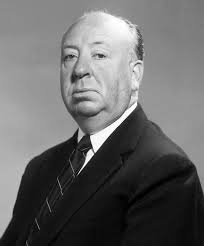
Alfred Hitchcock: Full Biography
Full Name: Sir Alfred Joseph Hitchcock
Date of Birth: August 13, 1899
Place of Birth: Leytonstone, London, England
Date of Death: April 29, 1980
Place of Death: Bel Air, Los Angeles, California, USA
Nationality: British (later became a U.S. citizen in 1956)
Profession: Film Director, Producer, Screenwriter
Early Life and Education
Alfred Hitchcock was born into a lower-middle-class family in Leytonstone, London. His father, William Hitchcock, was a greengrocer, and his mother, Emma Jane Hitchcock, was a homemaker. Hitchcock was raised in a strict Roman Catholic household, and his upbringing deeply influenced the themes of guilt, fear, and moral ambiguity present in his films.
At age 5, Hitchcock experienced an incident that would shape his view of authority and punishment: his father once sent him to the local police station with a note instructing the officers to lock him up for a few minutes as a lesson on misbehavior. This experience reportedly fueled Hitchcock’s lifelong fear of authority and the recurring theme of wrongly accused protagonists in his films.
Hitchcock attended the Jesuit-run St. Ignatius College and later studied engineering and navigation at the London County Council School of Engineering and Navigation. However, his passion for storytelling, art, and photography led him toward a career in film.
Early Career in Silent Films
Hitchcock’s entry into the film industry began in the early 1920s when he worked as a title card designer for silent films at the Famous Players-Lasky studio in London. His attention to detail and innovative storytelling techniques quickly earned him promotions, and he soon moved into screenwriting and assistant directing.
In 1925, Hitchcock directed his first feature film, “The Pleasure Garden”. However, his breakthrough came with “The Lodger: A Story of the London Fog” (1927), a suspenseful thriller about a man suspected of being a serial killer. The film introduced many elements that would become Hitchcock trademarks: a wrongly accused protagonist, the theme of duality, and the use of suspense to captivate audiences.
Transition to Sound and British Masterpieces
Hitchcock successfully transitioned from silent films to sound films, becoming a pioneering figure in early British cinema. His first sound film, “Blackmail” (1929), is often considered the first British “talkie.” Hitchcock used sound innovatively, enhancing tension and psychological depth.
Throughout the 1930s, Hitchcock directed several successful British films, including:
- “The Man Who Knew Too Much” (1934)
- “The 39 Steps” (1935)
- “Secret Agent” (1936)
- “Sabotage” (1936)
- “The Lady Vanishes” (1938)
These films established Hitchcock as the “Master of Suspense,” blending intrigue, espionage, and psychological tension with his distinctive visual style.
Move to Hollywood and International Success
In 1939, Hitchcock moved to Hollywood after signing a contract with David O. Selznick, a prominent American producer. His first American film, “Rebecca” (1940), starred Laurence Olivier and Joan Fontaine and won the Academy Award for Best Picture, though Hitchcock himself was famously snubbed for Best Director—a pattern that would repeat throughout his career.
Hitchcock continued to direct a series of critically acclaimed films in Hollywood, including:
- “Suspicion” (1941)
- “Shadow of a Doubt” (1943)
- “Notorious” (1946)
- “Rope” (1948) – Known for its experimental use of long, unbroken takes to create the illusion of a single continuous shot.
The Golden Era: 1950s to 1960s
The 1950s and 1960s marked the peak of Hitchcock’s career, during which he directed some of the most iconic films in cinematic history:
- “Strangers on a Train” (1951)
- “Dial M for Murder” (1954)
- “Rear Window” (1954) – Starring James Stewart and Grace Kelly, this film explored voyeurism and urban isolation.
- “To Catch a Thief” (1955)
- “The Man Who Knew Too Much” (1956) – A remake of his 1934 film, starring James Stewart and Doris Day.
- “The Wrong Man” (1956)
- “Vertigo” (1958) – Initially met with mixed reviews, Vertigo is now considered one of the greatest films ever made, known for its psychological complexity and innovative use of color and camera techniques.
- “North by Northwest” (1959) – A thrilling adventure featuring Cary Grant and the famous Mount Rushmore climax.
- “Psycho” (1960) – Perhaps Hitchcock’s most famous film, Psycho shocked audiences with its unexpected plot twists, the infamous shower scene, and the chilling performance of Anthony Perkins as Norman Bates.
- “The Birds” (1963) – A pioneering horror film that used special effects to create a terrifying portrayal of nature turning against humanity.
Later Career and Final Films
Though Hitchcock’s later films were not as commercially successful, they continued to showcase his mastery of suspense and innovative techniques:
- “Marnie” (1964)
- “Torn Curtain” (1966)
- “Topaz” (1969)
- “Frenzy” (1972) – A return to his British roots, featuring darker, more explicit themes.
- “Family Plot” (1976) – His final film, a lighter, more comedic suspense thriller.
Personal Life
Hitchcock married Alma Reville, a fellow screenwriter and film editor, in 1926. Alma was a crucial collaborator throughout his career, often contributing to the development of scripts and editing decisions. The couple had one daughter, Patricia Hitchcock, who occasionally acted in his films.
Despite his professional success, Hitchcock was known for his complex relationships with actors, particularly his leading ladies, such as Grace Kelly, Ingrid Bergman, Tippi Hedren, and Janet Leigh. His obsession with Tippi Hedren, the star of The Birds and Marnie, was particularly controversial and has been the subject of much debate.
Directorial Style and Influence
Hitchcock’s films are characterized by their masterful use of suspense, innovative camera techniques, and exploration of psychological themes. He often appeared in cameo roles in his films, turning this into a signature feature that audiences eagerly anticipated.
His recurring motifs include:
- The “wrong man” theme – Innocent protagonists accused of crimes they didn’t commit.
- Blondes in peril – Many of Hitchcock’s leading ladies were blonde, symbolizing both purity and danger.
- Voyeurism – The act of watching, and the consequences of doing so, play a significant role in films like Rear Window.
- MacGuffin – A plot device that drives the story but may have little actual significance to the characters or audience.
Hitchcock’s influence on cinema is profound, inspiring countless directors, including Steven Spielberg, Brian De Palma, Martin Scorsese, and Christopher Nolan.
Awards and Recognition
Despite being one of the most influential directors in history, Hitchcock never won an Academy Award for Best Director, though he was nominated five times. However, his contributions to cinema were recognized in other ways:
- Irving G. Thalberg Memorial Award (1968) from the Academy of Motion Picture Arts and Sciences.
- Golden Globe Cecil B. DeMille Award (1972).
- BAFTA Fellowship Award for lifetime achievement.
- Knighthood from Queen Elizabeth II in 1980, shortly before his death.
Death and Legacy
Alfred Hitchcock passed away on April 29, 1980, from kidney failure in Bel Air, Los Angeles, at the age of 80. His legacy continues to shape the film industry, and his works are studied extensively in film schools worldwide.
Hitchcock’s films are regularly included in “greatest films of all time” lists, and his techniques have become fundamental principles in the art of filmmaking. Vertigo topped the British Film Institute’s 2012 Sight & Sound poll as the greatest film of all time, surpassing Citizen Kane.
SOCIAL MEDIA LINKS :
YOUTUBE : https://www.youtube.com/watch?v=LO_8ww8DZeg&pp=ygUaQWxmcmVkIEhpdGNoY29jayBpbnRlcnZpZXc%3D



